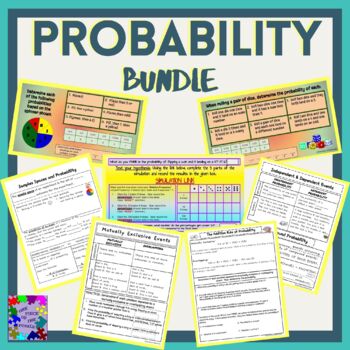Probability Bundle
One Piece of the Puzzle
24 Followers
Grade Levels
7th - 10th
Subjects
Resource Type
Standards
CCSS7.SP.C.8a
CCSS7.SP.C.8b
CCSSHSS-CP.A.2
CCSSHSS-CP.B.7
Formats Included
- Zip
One Piece of the Puzzle
24 Followers
Products in this Bundle (5)
Description
This product provides a notetaking guides for:
Sample Space and Probability (Geometric Probability included) Guided Notes
Experimental Probability Simulations
Independent and Dependent Events Guided Notes
Mutually Exclusive and Addition Rule of Probability Guided Notes
It also includes a practice activity:
Probability: Independent & Dependent Events BREAK THE CODE
Prerequisites: Students should already know how to find basic probability.
Includes all of the linked resources above.
This was designed to satisfy the common core standard:
CCSS.7.SP.C.8a and b, CCSS.HSS-CP.A.2, CCSS.HSS-CP.B.7
Georgia Standard: MGSE.7.SP.C.8, MGSE9-12.CP.A.2, MGSE9-12.CP.B.7
Total Pages
Answer Key
N/A
Teaching Duration
N/A
Report this resource to TPT
Reported resources will be reviewed by our team. Report this resource to let us know if this resource violates TPT’s content guidelines.
Standards
to see state-specific standards (only available in the US).
CCSS7.SP.C.8a
Understand that, just as with simple events, the probability of a compound event is the fraction of outcomes in the sample space for which the compound event occurs.
CCSS7.SP.C.8b
Represent sample spaces for compound events using methods such as organized lists, tables and tree diagrams. For an event described in everyday language (e.g., “rolling double sixes”), identify the outcomes in the sample space which compose the event.
CCSSHSS-CP.A.2
Understand that two events 𝘈 and 𝘉 are independent if the probability of 𝘈 and 𝘉 occurring together is the product of their probabilities, and use this characterization to determine if they are independent.
CCSSHSS-CP.B.7
Apply the Addition Rule, 𝘗(𝘈 or 𝘉) = 𝘗(𝘈) + 𝘗(𝘉) – 𝘗(𝘈 and 𝘉), and interpret the answer in terms of the model.


